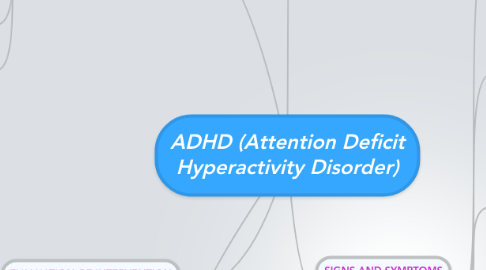
1. PREVENTION (causes)
2. ASSESSMENTS (how diagnosed)
2.1. specalist will come to childs school and home environment and assess and evaluate the child
2.2. By family Pediatrician or Mental health specalist
2.2.1. If child is having seizures
2.2.2. has middle ear infection causing hearing problems
2.2.3. any medical problems that affect thinking and behaviour
2.2.4. has a learning dissability
2.2.5. affected by a family death, or divorce, or parents job loss
2.3. are behaviours long term,continuous and permanent and do they affect every aspect of childs life in different settings
2.4. does this happen to child more then other children
3. EVALUATION OF INTERVENTION
3.1. Based on DSM-IV Diagnostic Criteria:
3.1.1. combination of at least 6-9 inattention symtoms
3.1.1.1. a. fails to close attention to detail
3.1.1.2. b. difficulty sustaining attention to tasks or play
3.1.1.3. c. doesnt listen when spoken to
3.1.1.4. d. doesnt follow through with instructions and fails to finish schoolwork or chores
3.1.1.5. e. difficulty organizing tasks or activities
3.1.1.6. f. avoids engaging in tasks that require sustained mental effort
3.1.1.7. g. loses things
3.1.1.8. h. easily disracted
3.1.1.9. i. forgetful in daily activities
3.1.2. combination of at least 6-9 hyperactivity-impulsivity indicators are endorsed
3.1.2.1. hyperactivity
3.1.2.1.1. a. fidgets hands or feet or sqirm
3.1.2.1.2. b. leaves seat in classroom, doesnt remain seated
3.1.2.1.3. c. runs or climbs excessively when innapropiate
3.1.2.1.4. d. difficulty playing in leisure activities
3.1.2.1.5. e. on the go or driven like a motor
3.1.2.1.6. f. talks excessively
3.1.2.2. impulsivity
3.1.2.2.1. g. blurts out answers before questions are completed
3.1.2.2.2. h. difficulty awaiting turn
3.1.2.2.3. i. interrupts or intrudes others
4. SIGNS AND SYMPTOMS
4.1. Impulsivity
4.1.1. very impatient
4.1.2. blurt out innapropiate comments/ emotions
4.1.3. difficultly waiting for turn (ex. games)
4.1.4. interupt others
4.2. Hyperactivity
4.2.1. fidget or squirm
4.2.2. talk nonestop
4.2.3. play/touch something always
4.2.4. in constant motion
4.3. Inattention
4.3.1. easily disracted
4.3.2. miss details
4.3.3. difficulty focusing
4.3.4. difficulty completing assignments
4.4. Other
4.4.1. Genetic
4.4.1.1. thinner brain tissue, from parents
4.4.2. Environmental Factors
4.4.2.1. mother smoked or drank during pregnancy
4.4.3. Brain Injuries
4.4.3.1. suffered from traumatic brain injury
4.4.4. Food/sugar
4.4.4.1. refined sugars and aspertame consumption
4.4.5. Coexisting Conditions
4.4.5.1. having a learning disability
4.4.5.2. oppositional defiant disorder
4.4.5.3. conduct disorder
4.4.5.4. anxiety and depression
4.4.5.5. bipolar disorder
4.4.5.6. tourette's syndrome
4.4.5.7. sleep disorder
4.4.5.8. bed wetting
5. TREATMENT PLANS
5.1. Medication
5.1.1. Stimulant or Non-Stimulant
5.1.1.1. pill, capsule, liquid or skin patch
5.1.2. short or long lasting
5.1.2.1. long lasting = long acting, means it stays in the body for a long time
5.1.3. side effects
5.1.3.1. decreased appitite
5.1.3.2. sleep problems
5.1.3.3. tics
5.1.4. helps control symptoms but does not cure ADHD
5.2. Parental Support
5.2.1. help guide and support their child
5.2.2. give child positive reinforcements
5.2.3. parents can benefit from learning stress management techniques
5.2.4. help kids stay organized by making them follow a routine or schedule, organize everyday items, use homework organizers, be clear and consistent, give praise and rewards
5.3. Pyschotherapy
5.3.1. help with practical assistance
5.3.2. behavioural therapy, helps to monitor their behaviour
5.3.3. give positive or negative feedback
5.3.4. help with social skills
5.3.5. helps with social skills training
